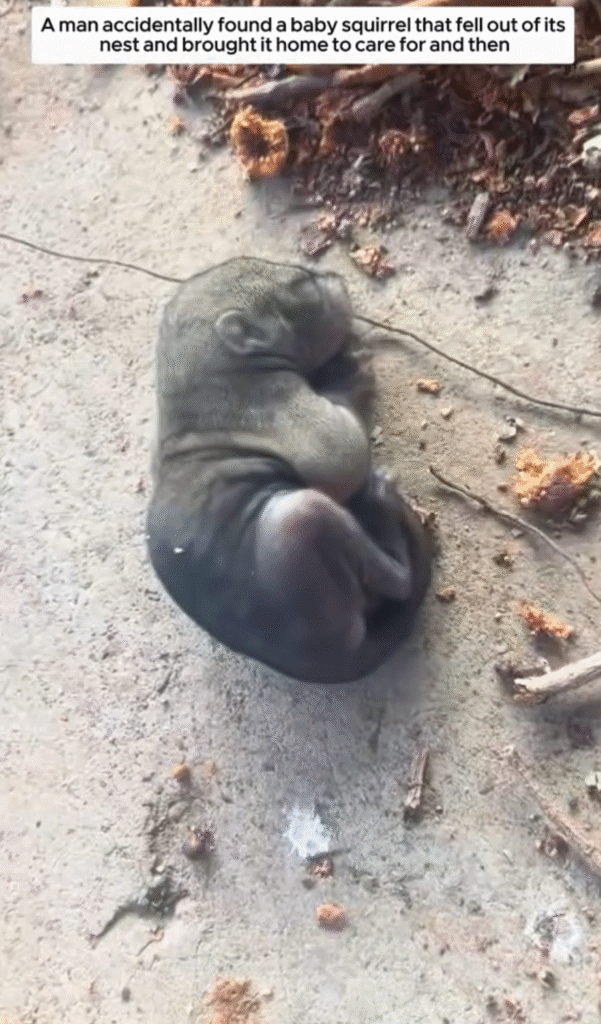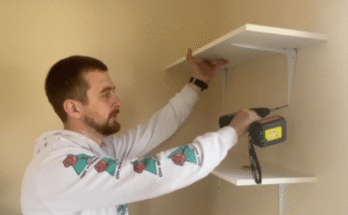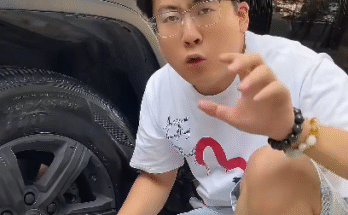It was a quiet afternoon in the countryside, the kind where the air feels still and the only sounds are the rustling leaves and chirping birds. Under a tall oak tree near a small farmhouse, something stirred in the grass. It was small, trembling, and barely moving—a poor baby squirrel that had fallen from its nest.
The little creature, later nicknamed BabySquirrel by the children of the house, looked confused and helpless. Its fur was still thin, eyes not fully open, and its tiny limbs shook from the unexpected fall. It was clear that BabySquirrel wouldn’t survive long without help.
Luckily, a young girl named Lila was playing nearby when she noticed a faint squeaking sound. At first, she thought it was a bird. But as she followed the sound closer, her heart dropped when she saw the tiny body lying in the grass. It was so small and fragile, with little movement, and clearly in distress.
“Poor baby squirrel,” Lila whispered, gently picking it up with trembling hands. She carefully placed the baby in her scarf and ran toward the house, calling for her grandmother, who had experience rescuing small animals. “Grandma! Come quick! Something’s wrong with this baby squirrel!”

The First Steps of Rescue
Lila’s grandmother examined the squirrel gently. “It’s very young,” she said. “Just a few weeks old. It’s dehydrated and probably cold.”
They quickly prepared a small box with a soft cloth, a heating pad set on low, and placed the baby squirrel inside. They warmed a special formula made for baby animals and fed it drop by drop with a small syringe.
BabySquirrel was weak but showed signs of life. It squeaked softly and grasped at Lila’s finger with its tiny paws. “You’re going to be okay,” Lila whispered, “We’ll take care of you.”
For the next few days, the entire family took turns caring for the baby squirrel. They fed him every two hours, kept him warm, and talked to him softly so he wouldn’t feel alone. Each day, BabySquirrel grew a little stronger.

Building a Bond
Lila spent the most time with BabySquirrel. She sang to him, watched over his naps, and cheered every time he gained a little weight. She even created a tiny play area in a shoebox, decorating it with leaves and twigs so it felt more like home.
The two formed a powerful bond. BabySquirrel would perk up at the sound of Lila’s voice and even tried to crawl toward her. He loved snuggling into the collar of her sweater and often fell asleep on her shoulder.
As BabySquirrel began to grow, his fluffy tail started to take shape. His fur became soft and full, and his eyes opened wide, revealing a curious, bright personality. He would explore his box, nibble on soft fruits, and practice climbing up Lila’s arm.
But even as he grew healthier, Lila never forgot the day she found him—so small, fragile, and lost. “You’re still my poor baby squirrel,” she would say with a smile, hugging him close.


Learning to Be a Squirrel Again
Though the bond between Lila and BabySquirrel was strong, Grandma reminded her that squirrels were wild animals. “If he gets too used to us,” she said, “he won’t know how to live in the forest. We need to teach him how to be a squirrel again.”
So they created a transition habitat outside—a large enclosure with branches, leaves, and platforms. Every day, BabySquirrel spent more time in the outdoor space, learning to climb, jump, and hide food.
Lila watched with pride as BabySquirrel became more confident in his movements. He learned to crack open nuts, balance on twigs, and react quickly to birds and other noises. Sometimes he would still climb onto Lila’s shoulder, nuzzle her cheek, and squeak softly. But he also began to explore farther, preparing for the day he’d return to the wild.



